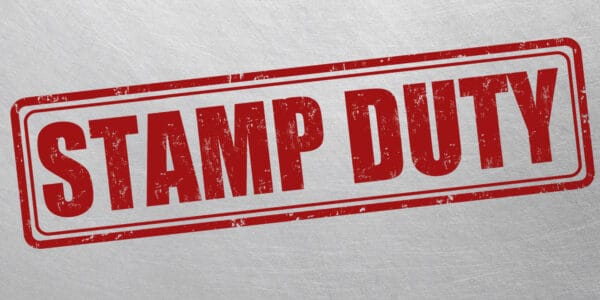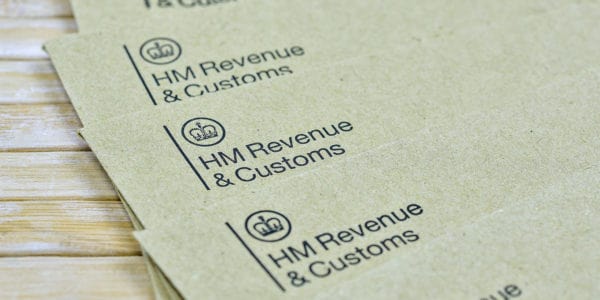There are three types of Stamp Duty tax that limited companies have to pay in certain circumstances. The first two are Stamp Duty and Stamp Duty Reserve Tax (SDRT) on the transaction value of transferred shares. The third is Stamp Duty Land Tax (or equivalent) on the purchase price of real estate.
Key takeaways
- Limited companies must pay Stamp Duty on share transfers exceeding £1,000, either via stock transfer form or electronically.
- Stamp Duty Land Tax rates vary based on property type and purchase price, with specific higher rates for companies.
- Companies are exempt from Stamp Duty when selling shares but may incur Capital Gains Tax on profits from sales.
We explore this topic in more detail below, including when these different types of Stamp Duty apply and the rates you may need to pay to HMRC.
Paying Stamp Duty on limited company shares
Most people only associate Stamp Duty with buying real estate property. However, it also applies to transferring shares in a limited company.
Upon the transfer of existing shares from one person to another, the new shareholder will be required to pay:
- 0.5% Stamp Duty if the transaction is over £1,000 and the shares are transferred using a stock transfer form, or
- 0.5% Stamp Duty Reserve Tax (SDRT) if the shares are transferred electronically through the ‘CREST’ system (a digital register of shares and shareholders)
Stamp Duty and SDRT liability are based on how much you pay for shares, not what they are actually worth.
Stamp Duty when buying shares using a stock transfer form
If you buy shares on paper using a J30 stock transfer form, you must round up the Stamp Duty liability on the transaction value to the nearest £5. For example:
- You buy shares for £2,250
- 0.5% Stamp Duty on this amount is £11.25
- You will round this up and you will pay £15 Stamp Duty
Within 30 days of the stock transfer form being signed and dated, you must send a copy to HMRC’s Stamp Office by email or post.
You will also need to pay the Stamp Duty you owe within this same timeframe, by either Faster Payment (online banking), Bacs, or CHAPS. Failing to make a payment by the deadline may result in a penalty and/or interest being charged.
Once paid, you must email your Stamp Duty notification to HMRC, which should include the following details:
- Payment reference
- Payment amount
- The date on which you made the Stamp Duty payment
- An electronic copy (e.g. a scanned PDF) of the signed and dated stock transfer form, an instrument of transfer, or Companies House form SH03 (whichever applies to the transfer)
If you are unable to submit your notification by email, you can send it by post to HMRC’s Stamp Office.
You will not have to pay Stamp Duty on any share transfer transaction under £1,000, regardless of the market value of the shares you receive.
Stamp Duty Reserve Tax (SDRT) when buying shares electronically
Stamp Duty Reserve Tax (SDRT) is a different type of tax due only on shares that you buy electronically (i.e. paperless share transfers). It is not the same as Stamp Duty on shares transferred on a paper stock transfer form.
SDRT payments apply to stocks and shares bought in one of two ways:
- Through the ‘CREST’ system, which is a computerised register of shares and shareholders
- Off-market payments outside of the CREST system
If you buy shares through CREST, the 0.5% SDRT payment on the transaction is calculated and paid to HMRC automatically. There is no need to manually notify or pay HMRC after the share transfer takes place.
However, if you buy shares outside of CREST, you must send a written notice of the transaction to HMRC. This should include the following information:
- Details of the buyer and seller
- Quantity, class (type), and nominal value of shares that have been transferred
- Any relief or exemption being claimed
- The amount that was paid for the shares, or the value of any non-cash consideration used as payment instead of cash
- A reference number (chosen by you) to enable HMRC to identify the payment
The deadline for sending this notice and paying SDRT to HRMC is the 7th of the month after which the transfer takes place.
However, if you could have made the SDRT payment through CREST but chose not to, the deadline for sending the notice and paying the tax is 14 days from the date of the trade.
If you do not pay anything for the shares (i.e. they are gifted to you for free), you do not have to pay any Stamp Duty Reserve Tax.
Types of share transfers you pay tax on
You will pay tax on shares when you buy:
- Existing shares in a UK company (i.e. when shares are transferred from one person to another)
- An option to buy shares
- An interest in shares, e.g. an interest in the money acquired from selling them
- Shares in an overseas company that keeps a share register in the UK
- Rights arising from shares, e.g. the rights that you have when a company issues new shares
Types of share transfers you do not pay tax on
You do not have to pay any tax on shares if you:
- Receive shares for nothing (i.e. they are given to you as a gift)
- Buy newly issued shares in a company
- Purchase shares in an ‘open ended investment company’ (OEIC) from the fund manager
- Buy units in a unit trust from the fund manager
Typically, you do not have to pay Stamp Duty or Stamp Duty Reserve Tax if you purchase foreign shares outside the UK. However, you may have to pay Income Tax on any investment income you receive from those shareholdings.
Additionally, you may be liable to Capital Gains Tax when you sell your shares in the future.
Do you pay Stamp Duty or SDRT when selling shares?
Neither companies nor shareholders pay Stamp Duty or SDRT when they sell or transfer shares. This includes when companies issue new shares and when shareholders sell or give away existing shares that they own.
However, you may have to pay Capital Gains Tax (CGT) on any profit (gain) you make when selling existing shares unless they are:
- Held in an ISA or PEP
- Shares in an employer Share Incentive Plan (SIP)
- UK government gilts, including Premium Bonds
- Qualifying Corporate Bonds
- Employee shareholder shares, depending on when you received them
Currently, there is an annual capital gains tax-free allowance of £3,000. This means that you do not pay any tax on gains up to that amount.
Stamp Duty Land Tax (SDLT) for limited companies
Stamp Duty Land Tax (SDLT) is a progressive tax that individuals and corporate bodies (e.g. companies) must pay when they buy or acquire land or property over a certain price in England or Northern Ireland. It is charged as a percentage of the property value.
The rules are different if you buy property or land in Scotland or Wales. In Scotland, you pay Land and Buildings Transaction Tax. In Wales, you pay Land Transaction Tax.
How much SDLT will I pay through a limited company?
There are different rates and thresholds of Stamp Duty Land Tax, depending on the purchase price and type of property.
When you purchase residential property through a company, you will be subject to the higher residential rates of SDLT if the:
- Property costs £40,000 or more
- The interest you buy is not subject to a lease on which more than 21 years are left
From 1 April 2025, the higher rates of SDLT are as follows:
| Property or lease premium or transfer value | Percentage |
| Up to £40,000 | 0% |
| Up to £125,000 | 5% |
| The next £125,000 (the portion from £125,001 to £250,000) | 7% |
| The next £675,000 (the portion from £250,001 to £925,000) | 10% |
| The next £575,000 (the portion from £925,001 to £1.5 million) | 15% |
| The remaining amount (the portion above £1.5 million) | 17% |
These rates include a 5% SDLT surcharge on the normal residential rates, which applies to purchases of additional residential property by individuals and companies for more than £40,000. Non-UK resident companies and individuals pay an additional 2% surcharge on top of the higher-rate surcharge.
However, if you buy a residential property for more than £500,000 through a limited company, the 17% higher threshold SDLT rate for corporate bodies will apply instead, unless the company is acting as a trustee of a settlement.
You may be able to benefit from Stamp Duty Land Tax relief from the 17% corporate rate if the property is:
- Part of a property rental business
- Purchased by a property developer or trader
- Used in any trade that is involved in making the dwelling available to the public
- Purchased by a financial institution in the course of lending
- Occupied by employees of the company
- Currently (or going to be) a farmhouse
- Bought by a qualifying housing co-operative
What type of property does SDLT apply to?
Stamp Duty Land Tax is payable on the purchase of:
- Freehold property
- New or existing leasehold property
- Property through a shared ownership scheme
You will also pay SDLT on any land or property that is transferred to you in exchange for payment (e.g. taking on a mortgage or buying a share in a house).
Do companies pay SDLT on commercial properties?
If you buy or lease a commercial (non-residential) or ‘mixed-use’ property through a limited company, you still have to pay Stamp Duty Land Tax.
You will pay non-residential SDLT rates on increasing portions of the price (or non-cash consideration) of the land or property if you pay £150,000 or more for it.
Commercial property includes:
- Retail units, offices, warehouses, factories, garages, workshops
- Property that is unsuitable to be lived in
- Agricultural land that is part of a working farm or is used for agricultural purposes
- Forests
- Any other type of land or property that is not used as a residential dwelling or part of a dwelling’s garden or grounds
- Six or more residential properties purchased in a single transaction
- “Mixed-use” properties – i.e. live/work spaces, like a flat connected to a shop
If you buy a freehold commercial property, you will pay the following rates of SDLT:
- 0% – on purchases up to £150,000
- 2% – on the portion from £150,001 to £250,000
- 5% – on any remaining portion above £250,000
When you buy a new non-residential or mixed leasehold property, the SDTL is calculated differently. It is based on:
- The lease premium (the price of the lease) using the rates listed above, and
- The net present value (the value of the rent you pay)
The net present value is based on the total amount of rent you will pay over the term of the lease. The rates are:
- 0% – up to £150,000
- 1% – on the portion from £150,001 to £5,000,000
- 2% – on any remaining portion above £5,000,000
These two SDLT liabilities – the ‘lease premium’ and the ‘net present value’ – are calculated individually and added together to determine how much you have to pay.
How and when do I pay SDLT?
When you buy a property over a certain price, you must send a Stamp Duty Land Tax return to HMRC and pay the SDLT you owe within 14 days of the transaction date. Typically, this is the date on which you completed the sale, but it could be earlier, such as the date:
- You are entitled to take possession of the property
- The first rental payment is due
- Of substantial completion, i.e. where at least 90% of the payment has been made
You are responsible for filing the return and paying the tax you owe. However, most people use a solicitor or legal conveyancer to carry out these duties on their behalf.
There are several ways you can pay your Stamp Duty Land Tax liability, including:
- Faster Payments through online or mobile banking
- Bacs
- CHAPS
- online using a debit or company credit card
- at your bank or building society
- by cheque through the post
Whichever method you choose, you will need to provide your 11-character Unique Transaction Reference Number (UTRN). You will find this on your paper return or electronic SDLT5 certificate.
Stamp Duty Land Tax is notoriously complex, regardless of whether you are buying as a private individual or through a corporation, like a limited company. Therefore, we strongly recommend seeking professional advice in the matter before proceeding with any property purchase.
So, there you have it… Stamp Duty for limited companies
We have discussed the three different types of Stamp Duty that limited companies have to pay in certain situations. These are Stamp Duty and SDRT on the transfer of shares, and Stamp Duty Land Tax when buying residential or commercial property through a company.
As previously mentioned, Stamp Duty can be a complex area to understand and navigate – particularly SDLT when buying land and property. For this reason, we would urge you to speak to an accountant or conveyancing solicitor for tailored, professional advice.
If you have any questions about this post or would like to know more about our company formation services, please contact us or leave a comment below.
Please note that the information provided in this article is for general informational purposes only and does not constitute legal, tax, or professional advice. While our aim is that the content is accurate and up to date, it should not be relied upon as a substitute for tailored advice from qualified professionals. We strongly recommend that you seek independent legal and tax advice specific to your circumstances before acting on any information contained in this article. We accept no responsibility or liability for any loss or damage that may result from your reliance on the information provided in this article. Use of the information contained in this article is entirely at your own risk.














Join The Discussion
Comments (6)
Nicholas,
The article above incorrectly states that 5% Stamp Duty is payable on share purchases, although the example calculation correctly applies the true rate of 0.5% Stamp Duty.
Dear John,
Thank you for your kind comment. Fantastic spot! Yes, you are correct, this 5% figure is incorrectly listed in the blog and as you mentioned should be 0.5% We will review the whole blog.
Once again, thank you for spotting this error.
Kind regards,
The QCF Team.
I am trying to purchase a property under my limited company to be used as a care home. Will this be classified as a commercial property or residential property
Thank you for your kind comment.
Unfortunately as we are not regulated to provide accountancy advice, we are unable to provide advice on specific scenarios. We would recommend contacting an accountant for further assistance.
Please accept our apologies for any inconvenience caused.
Kind regards,
The Quality Formations Team
Hi – I’m buying a property into my limited company for £39,999 which the .gov SDLT calculator states as zero SDLT liability.
However, other SDLT calculators and article statements suggest that SDLT is due at 5% on a purchase price between £0 and £125,0 00 i.e. £2000 being due
Can you point to a definitive statement as to which it is please?
Thanks
Bob
Thank you for your kind comment.
Unfortunately as we are not regulated to provide accountancy advice, we are unable to provide advice on specific scenarios. We would recommend contacting an accountant for further assistance.
Please accept our apologies for any inconvenience caused.
Kind regards,
The Quality Formations Team